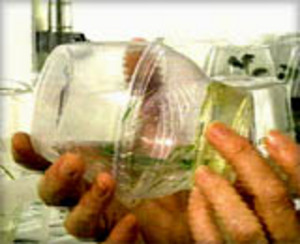Science — the old saying goes — is limited only by one’s ability to ask questions and search for answers. At the University of Florence – a group of researchers spliced a rat gene with that of a tobacco plant and created something….bigger,leafier and faster-growing and with a higher nicotine content, that is sure to have RJ Reynolds and everyone else who has a stake in the tobacco industry jumping for joy.
Did someone say….RAT…?
The research was recently conducted by Professor Marcello Buiatti and a team of researchers at the University of Florence, Italy. (La Repubblica (www.larepubblica.it, 1 March 2007)
How these researchers went about decided on splicing a rat cell and a tobacco cell together is complex enough to turn this article into a book, but the work underscores scientific research and development that is fast becoming an integral part of many facets of industry: the production of genetically modified organisms also known as genetic modification also referred to as GM.
Genetic modification sounds like something used to piece Frankenstein together, but is actually a special set of technologies that alter the genetic makeup of such living organisms as animals, plants, or bacteria. According to an article in NewScientist.com (www.newscientist.com), combining genes from different organisms is known as recombinant DNA technology, and the resulting organism is said to be “genetically modified,” “genetically engineered,” or “transgenic.” Genetically modified products include medicines and vaccines, foods and food ingredients, feeds, and fibers.
An article in NewsWeekInternational.com (www.msnbc.msn.com, February 2007) points out that the most significant genetic modification applications will be ones that help alleviate the problem of agriculture, which accounts for 38 percent of the world’s landmass and is crowding out natural ecosystems and species habitats. GM crops that can be produced more efficiently would allow us to return land to nature. Standing in opposition to these advances are advocates of an organic food philosophy that holds to the simplistic notion that “natural” is good and “synthetic” is bad.
Simple though that argument is, GM-produced “anything” is strictly monitored – especially when it comes to food. In the United States, produce doesn’t have to be labeled as “genetically modified.” And although there is a wealth of information recounting some of the more positive aspects of GM-produced foodstuffs, there is just as much — if not more information — that touts how anything genetically produced can do you serious harm.
It’s a ping-pong match of ideologies. Scope.education (www.scope.edu.washington.edu) sites for example that in 2005, close to 200 million acres grown by more than 7 million farmers in nearly 18 countries were planted with GM crops, the principal ones being herbicide- and insecticide-resistant soybeans, corn, cotton, and canola. Other crops grown commercially or field-tested are a sweet potato resistant to a virus that could decimate most of the African harvest, rice with increased iron and vitamins that may alleviate chronic malnutrition in Asian countries, and a variety of plants able to survive weather extremes. You’d think this would be a boon or the agriculture industry, but it actually upset a whole lot of people. Why? Because if crops are being grown “in-house” than it diminishes the need to export the crops we grow in the United States.
In fact, a recent international trade agreement adopted by delegates of 140 countries allow a country to ban the import of a genetically modified food – while at the same time allowing itself to pursue the same research and development of GM-agriculture.
It’s been nearly a decade since the concept of genetically modified foods has burst on the scene. It’ll probably be at least another decade before we decide whether we’re really on to something useful or not.



